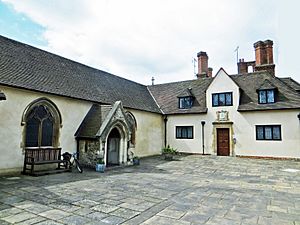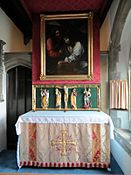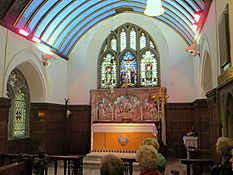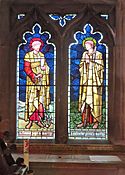Ilford Hospital Chapel facts for kids
The Hospital Chapel of St Mary the Virgin and St Thomas of Canterbury, Ilford, often called Ilford Hospital Chapel, is a very old building in Ilford. It's located on Ilford Hill. This special chapel was started around 1140. It is the oldest building in the whole London Borough of Redbridge. Since 1954, it has been protected as a Grade II* listed building. This means it's a very important historical place in the UK.
Contents
A Long History
The hospital was built on land owned by the Benedictine Abbey of Barking. It was founded during the time of King Stephen. The Abbess Adelicia (or Adeliza) started it as a hospice. A hospice is a place that cares for people who are sick or old. This one was for thirteen residents. Historians aren't sure if it was for old men or for people with leprosy.
Abbess Adelicia gave a lot of land and money to the hospital. This included land in Estholt, Upminster, and Aveley. She also gave a mill in Ilford and part of the income from the church at Barking. The hospital was run by a Prior or Master and had two chaplains.
Changes Over Time
In 1173, Mary Becket became the Abbess. She was the sister of Thomas Becket. He was a very important person who was murdered. Because of her, the chapel was made bigger. Her brother's name was added to the chapel's title.
Later, in 1539, King Henry VIII closed down many abbeys, including Barking Abbey. But the hospital survived! People think it survived because the chapel was also used by the public for worship. After the Abbey closed, the King took over the hospital.
In 1572, Elizabeth I gave the hospital to Thomas Fanshawe. He had to make sure there was a Master, a Chaplain, and support for six poor men. The Fanshawe family lost the hospital for a while during the Commonwealth period. But they got it back after the King returned to power in the Restoration.
Later, the hospital was owned by the Gascoyne family around 1727. Then, through marriage, it passed to the Marquesses of Salisbury in 1821. They owned it until 1982. The sixth Marquess then gave the hospital to the Diocese of Chelmsford. This group set up the Abbess Adelicia Charity. This charity now manages the site.
Since 1954, the hospital has been a listed building. It has Grade II* status, which is the second most important category for historic buildings.
Important Chaplains
Many interesting people have served as chaplains at the hospital. One was Hensley Henson, who was chaplain from 1895 to 1900. He later became a Bishop of Durham.
Building Structure
The hospital complex has the chapel in the middle. On each side, there are almshouses. Almshouses are special homes for people in need. These were where the poor men and chaplains lived. Today, the Abbess Adelicia Charity has changed the almshouses into modern flats inside.
The chapel walls are made of rubble covered with cement. The roofs are tiled. The main parts of the chapel, called the nave and chancel, were likely rebuilt in the 14th century.
Victorian Changes
The building had big changes in 1889–90. This was during the Victorian era. A north porch, organ chamber, south aisle, and vestry were added. Experts believe the nave was also made longer towards the west.
The chancel has an east window from the early 15th century. It has three lights, which are sections of the window, but it has been heavily repaired. There are also old windows from the late 14th or early 15th century in the north and south walls. Other parts of the chapel are from the 19th century or later.
The nave is the main part of the church. It has two old windows, probably from the early 14th century, that have also been repaired. The reredos, which is a decorated screen behind the altar, was made by Ninian Comper. The beautiful rose window above the west door is thought to be by Henry Holiday. The west aisle window was designed by Edward Burne-Jones. An organ was put in the chapel in the early 1900s. The chaplain's house and almshouses were rebuilt in 1927.
Visiting the Chapel
You can visit the chapel! There is a midday Communion service every Thursday. The chapel also has an open day on the second Saturday of each month from March to November. It also takes part in the yearly Open House London weekend in September. This is a special event where many historic buildings in London open their doors to the public.
Gallery
External links
- Official website: http://www.ilfordhospitalchapel.org.uk/





